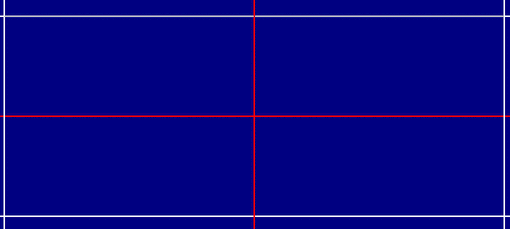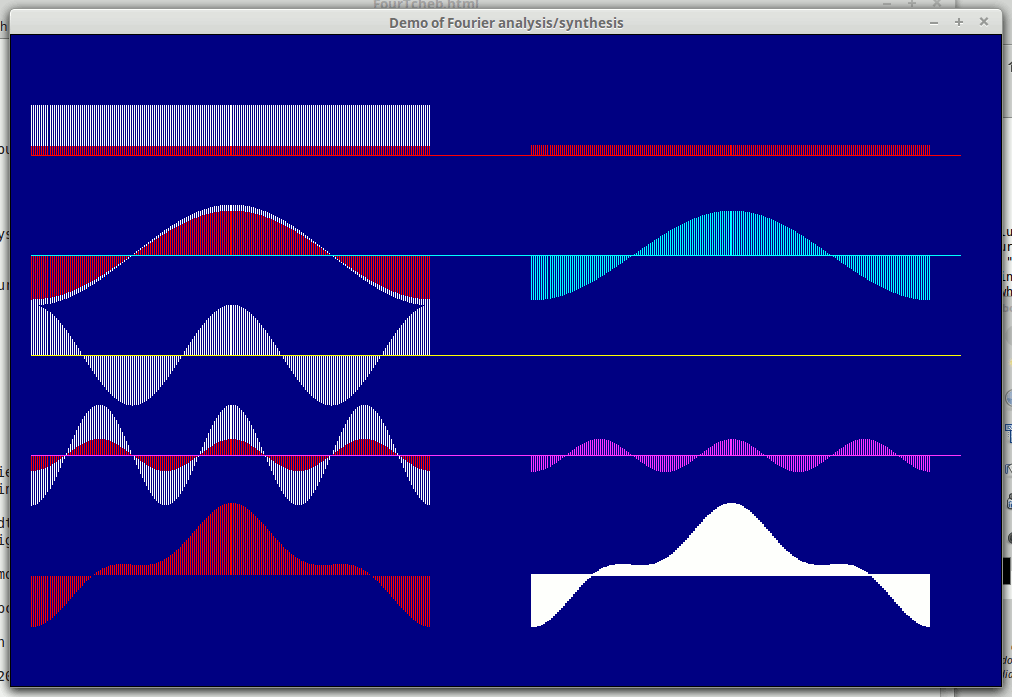Fourier Analysis and Synthesis.


The right hand side shows this ( approximately triangular) wave being taken as source, and the needed amplitudes are re-generated from it.

' Fourier
' nomainwin
WindowWidth =1000
WindowHeight = 680
open "Demo of Fourier analysis/synthesis" for graphics_nsb as #wg
#wg "trapclose quit"
#wg "down ; size 1 ; fill darkblue"
dim fn( 200)
k0 = 0.2: k1 = 0.9: k2 = 0: k3 = 0.333
col$( 0) ="red": col$( 1) ="cyan": col$( 2) ="yellow": col$( 3) ="255 60 255": col$( 5) ="black"
print " Synthesis & Analysis with Fourier Coefficients"
print
print " Term n calc'd fraction v/ spec'd fraction"
#wg "color red"
for n =0 to 3
#wg "color "; col$( n)
#wg "up ; goto 20 "; 120 +n *100; " ; down ; goto 950 "; 120 +n *100
next n
for j =-1 to 1 step 0.01 ' Display four Fourier components and the totalled function.
indx =int( 100 +j *100)
t0 =k0 *Fourier( 0, j)
#wg "color white ; up ; goto "; 220 +int( j *200); " "; 120 -Fourier( 0, j) *50
#wg "down ; goto "; 220 +int( j *200); " "; 120
#wg "down ; color red ; goto "; 220 +int( j *200); " "; 120 -t0 *50
t1 =k1 *Fourier( 1, j)
#wg "color white ; up ; goto "; 220 +int( j *200); " "; 220 -Fourier( 1, j) *50
#wg "down ; goto "; 220 +int( j *200); " "; 220
#wg "down ; color red ; goto "; 220 +int( j *200); " "; 220 -t1 *50
t2 =k2 *Fourier( 2, j)
#wg "color white ; up ; goto "; 220 +int( j *200); " "; 320 -Fourier( 2, j) *50
#wg "down ; goto "; 220 +int( j *200); " "; 320
#wg "down ; color red ; goto "; 220 +int( j *200); " "; 320 -t2 *50
t3 =k3 *Fourier( 3, j)
#wg "color white ; up ; goto "; 220 +int( j *200); " "; 420 -Fourier( 3, j) *50
#wg "down ; goto "; 220 +int( j *200); " "; 420
#wg "down ; color red ; goto "; 220 +int( j *200); " "; 420 -t3 *50
fn( indx) =t0 +t1 +t2 +t3
#wg "up ; goto "; 220 +int( j *200); " "; 540 -fn( indx) *50
#wg "down ; goto "; 220 +int( j *200); " "; 540
next j
for n =0 to 3
a( n) =0: b( n) =0
for j =-1 to 1 step 0.01 ' integrate up the product of my function fn( j) and Fourier( n, j) at each j.
a( n) =a( n) +fn( 100 +j *100) *Fourier( n, j)
b( n) =b( n) + Fourier( n, j)^2 ' what the integral would be if e() was just this Fourier term...
next j
if b( n) <>0 then frac( n) =( a( n) /b( n)) else frac( n) =0
#wg "color "; col$( n)
#wg "up ; goto 20 "; 120 +n *100; " ; down ; goto 950 "; 120 +n *100
for j =-1 to 1 step 0.01
fn( 100 +j *100) =fn( 100 +j *100) -frac( n) *Fourier( n, j)
#wg "color "; col$( n)
#wg "up ; goto "; 720 +int( j *200); " "; 120 +100 *n -int( frac( n) *Fourier( n, j) *50)
#wg "down ; goto "; 720 +int( j *200); " "; 120 +100 *n
next j
print " "; n, using( "##.######", frac( n)),,
select case n
case 0
print k0
case 1
print k1
case 2
print k2
case 3
print k3
end select
next n
#wg "size 2"
for j =-0.999 to 1 step 0.01
n =int( 100 +j *100)
fn( n) =frac( 0) *Fourier( 0, j) +frac( 1) *Fourier( 1, j) +frac( 2) *Fourier( 2, j) +frac( 3) *Fourier( 3, j)
#wg "color white"
#wg "up ; goto "; 720 +int( j *200); " "; 540 -int( fn( n) *50)
#wg "down ; goto "; 720 +int( j *200); " "; 540
next j
#wg "flush"
wait
function Fourier( n, x)
Fourier =cos( 3.14159265 *n *x)
end function
sub quit h$
close #wg
end
end sub